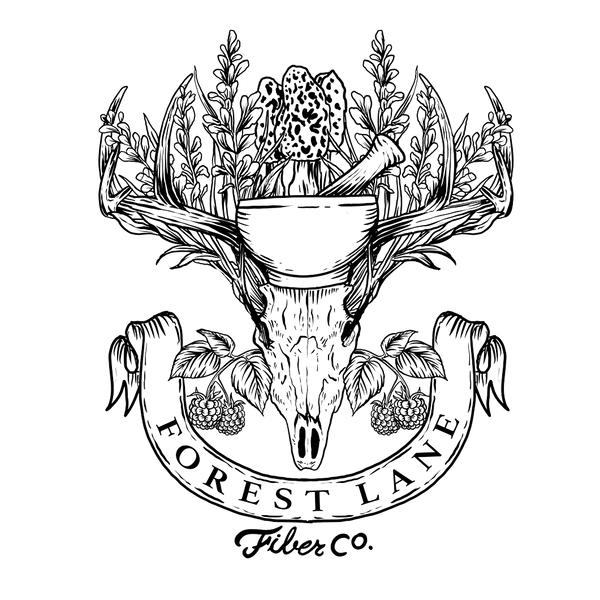4 Factors of Scratchy or Soft Wool
•Posted on September 20 2020

A special part of the indie-dyed yarn community is how most people use different bases of yarn. A common topic of conversation is how soft or scratchy a certain yarn is. From superwash to non-superwash, angora to Romney, the fibers spun into yarn differ widely. A cashmere blend is bound to be soft, a silk blend is bound to be smooth, but several people have been outright shocked at how nice certain non-superwash wool yarns are. Things like “This is non-superwash?!” “This is so soft for non-superwash!” and the like are thrown around. Superwash seems to be a big factor in how people perceive how a yarn will feel to them. Here’s the thing: superwash-treated yarn is not inherently softer than non-superwash. Non-superwash yarn is not inherently scratchy. I’ve felt some nasty scratchy superwash yarn and some fluffy cloud baby kitten tummy non-superwash yarn. There are several factors that go into the way yarn feels.
Superwash
I’m not here to tell you that superwash & non-superwash yarn feel identical, because they really don’t. Superwash yarn is made from wool that has been chemically treated to remove the scales on the wool fibers that cause felting, and then it is coated in an artificial wax-like substance to further smooth the fiber and prevent felting (and therefore shrinking). Superwash wool, in my opinion, feels a little bit slick in a plastic-y way, and some of it kind of has a squeaky feel to it when knitting with it, like acrylic. This yarn is great for dyers because it takes dye really well, and it’s great for gift-knitting because people can just throw whatever into the washing machine (although I personally wouldn’t recommend machine washing even superwash yarn!). However, this comes at a big environmental price.
Non-superwash yarn still has the scales on the fibers and is not coated in any plastic-wax. It will felt at high heat or agitation, but feels more wooly. Kind of like the difference between matte & glossy. It’s not as slick, which can make it feel much cozier, and, well, woolly!
Micron count
Yarns are made up of lots of individual fibers twisted together. Each individual fiber has a specific diameter or thickness. They’re obviously very small, so they’re measured in microns (1 millimeter has 1000 microns in it). Wool, and fibers from other animals, can vary widely in the micron count of their fibers. A very popular breed of sheep is Merino. Even among Merino sheep, the micron count can vary from as low as 15 to 24 microns (the lowest being for things that are spun very finely like textiles and 24 being more sturdy, like something you’d knit socks from). Cashmere must be less than 19 microns, human averages at about 75 microns, and wool for making rugs is 35-40 microns. Obviously a superfine merino wool, for example, is going to feel very soft whether it was superwash treated or not.
Ply structure
The number of plies, the twist on each ply, and the angle at which the plies are twisted together all impact the way that the yarn feels. The same fine Merino wool can feel entirely different even as two fingering weights, for example: a single ply, loosely spun is going to feel more lofty and softer versus a 4 ply that’s twisted at a high angle, which will feel much firmer and denser. Still soft, as in not prickly, but it will feel a lot different! There are infinite combinations of how to structure a fiber into yarn, and they’ll all differ.
Woolen vs Worsted
I think something people who are only used to working with superwash yarn come across is the big difference between the way woolen- and worsted-spun yarn feels. Worsted-spun yarn is probably what most people have been exposed to – each of the fibers are combed until they are oriented straight next to each other, and are then spun into yarn. This produces a very smooth yarn. Woolen-spun yarn, however, doesn’t go through nearly as much smoothing. It is carded enough to not be tangled, but at that point, the fibers are oriented as they see fit (which means in every which way). This produces a yarn that is usually fluffier in appearance with the fibers being grippier to each other since they are not smoothed straight. Technically, wool can be superwash-treated and then spun into yarn in a woolen fashion, but I’ve never seen any before. While woolen-spun yarn may not feel as smooth as worsted spun yarn, it may still be as soft. It’s like the difference between curly hair and straight hair. You wouldn’t say somebody with fine curly hair had hair any less soft that somebody with fine straight hair.
So if you’ve ever experienced a scratchy yarn, there were a lot of factors that went into it. If superwash is a main feature you look for when buying yarn, ask yourself why. If you think it’s de facto softer yarn, it may not be the case! If you really just want to throw your socks in the wash, buy superwash! If you want a garment that will keep you as warm as possible, choose something with a relatively low micron count that is non-superwash so the fibers will lock together gently and form a heat-cold barrier (better yet if it’s woolen-spun). If you want to branch out with the breed of wool you’re knitting with, non-superwash is generally easier to find things outside of Merino! Whatever you’re looking for, the right yarn is out there for you. Hand-making garments and accessories is as personal and unique in materials used as each of us who are making them. Superwash does affect the way yarn feels, but not really the softness of it! The moral of the story is, if you want soft yarn, you can get it without paying the price environmentally.




Comments
0 Comments
Leave a Comment